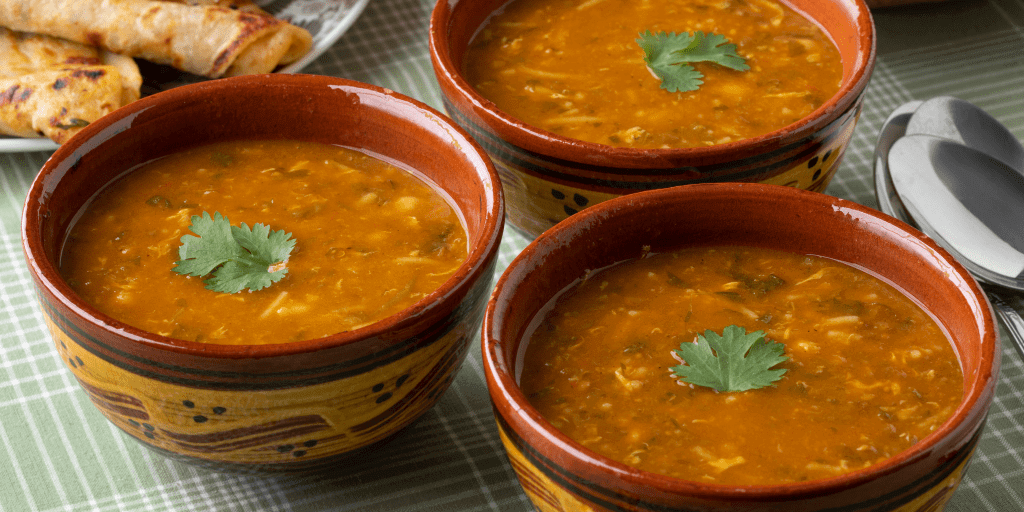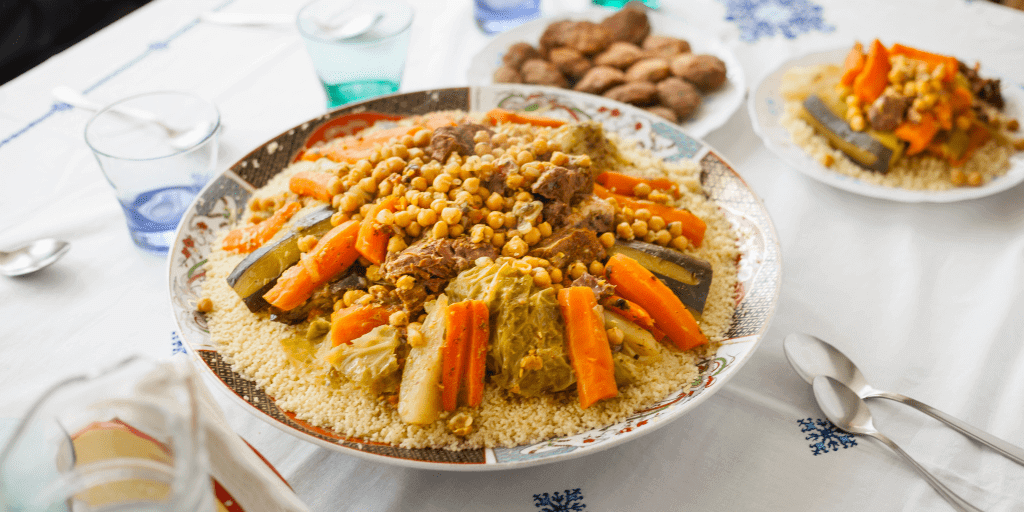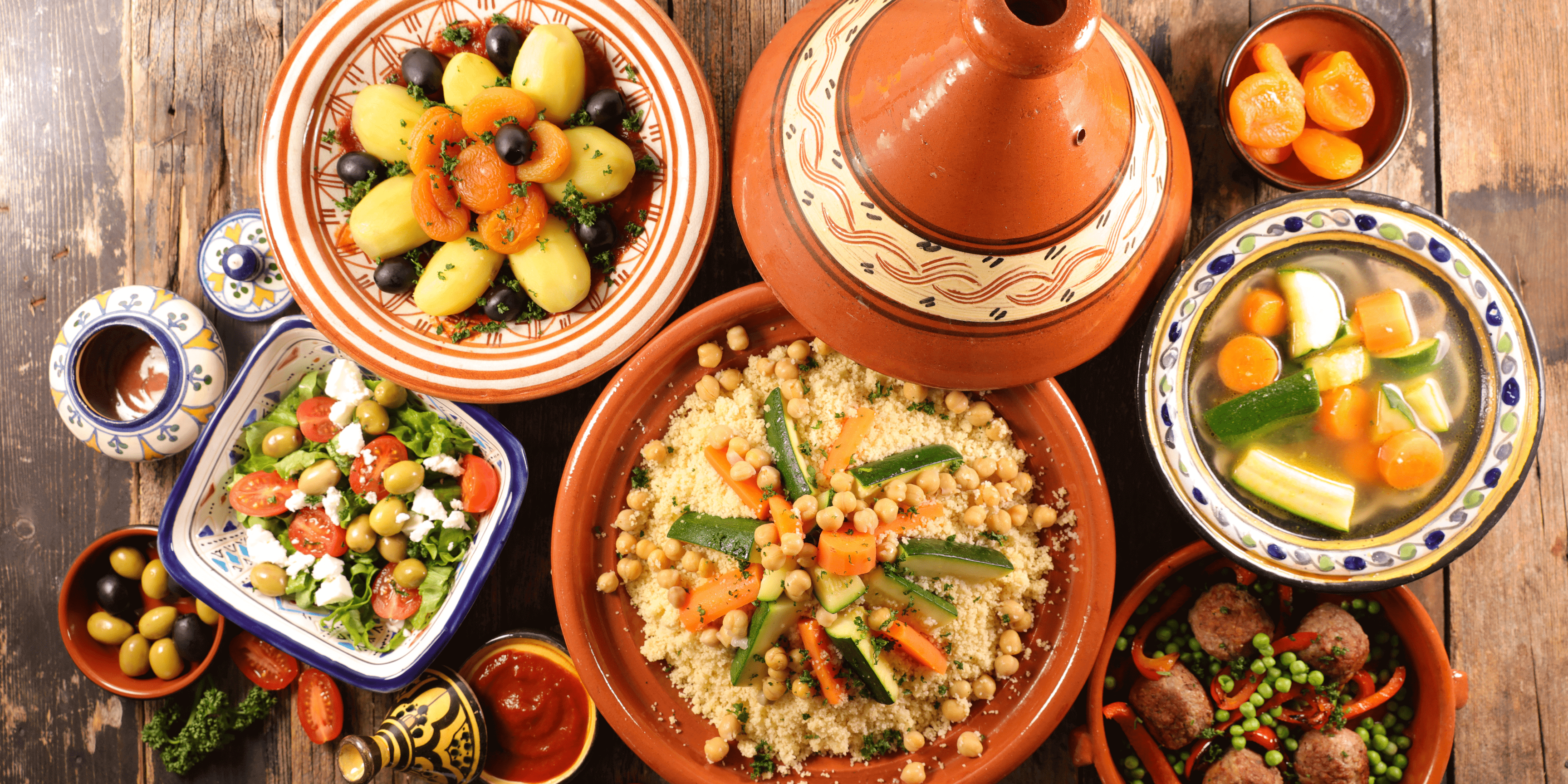Moroccan Cuisine: 6 Must-Try Foods
Moroccan food is recognized for its distinctive taste combination, which combines elements from North African, Arabic, and Mediterranean cuisines. There are various eating alternatives available in the nation, ranging from upscale restaurants to busy street food stands, but many residents think that the only way to experience the authentic flavor of Morocco is to eat its street cuisine.
The Medina is the best location to discover Morocco’s gastronomic offers because it is home to hundreds of kiosks providing a wide variety of foods. Bread vendors, butchers, and other food vendors are grouped together and are serving up a mouthwatering array of regional specialties.
Fez, Marrakech, and Essaouira are frequently mentioned as the greatest locations for foodies to visit in Morocco even though many Moroccan cities have wonderful street cuisine. In addition to being well-liked tourist attractions, these cities provide a unique opportunity to experience both the local culture and delectable cuisine.
Skip the posh restaurants and walk directly to the Medina after 9 o’clock at night when the streets come alive with the sights, sounds, and aromas of street food if you want to sample the finest of Moroccan cuisine. It’s important to remember that Moroccans often eat their meals slowly over a period of many hours, so take your time when trying the food of this region.
The following are the Top 6 Moroccan dishes that you just must try:
1. Tagine.

Tagine is a traditional Moroccan meal that is both tasty and healthful. It is a stew comprised of tender vegetables, beef, olives, dried fruits, and preserved lemons prepared with a mixture of flavorful Moroccan spices. The meal is slow-cooked in a large, low pot with a lid to make tagine, which enables the flavors to meld and deepen over time.
The scents and tastes of tagine are traditionally enhanced by cooking it in terracotta pots. The slow cooking method also makes the meat and veggies supple and luscious, giving this a hearty and fulfilling dinner.
Tossing large pieces of bread, known as khobz, into the stew is one of the most significant ways to enjoy tagine. Each bite will be considerably more delightful due to soaking up all the great tastes and liquids from the meal.
There are several Tagine varieties, each with its unique tastes and components. A few well-liked choices include the tender Beef with Prune Tagine, which blends the savory flavor of beef with the delicious flavor of prunes, and the spicy Fish Tagine, which combines Moroccan spices and fresh fish.
There are several recipes online that may help you through the process of creating tagine at home. You can replicate the mouthwatering flavors of Morocco in your home kitchen with a little time and the correct supplies.
2. Chebakia.

Both natives and visitors to Morocco love the renowned dessert known as chebakia. Especially during Ramadan, when they are frequently devoured by Muslims who fast from dawn to dusk, these flower-shaped, fried sesame biscuits are a must-try when traveling to Morocco.
Chebakia-making is a labor-intensive procedure that calls for patience and talent. The dough is prepared with flour, yeast, and a mixture of fragrant spices like anise, cinnamon, and sesame seeds. The dough is next worked, rolled out, and cut into strips. These are then twisted into the distinctive Chebakia flower form.
After being cut out, the cookies are deep-fried till golden brown before being covered in a hot honey syrup, which gives them their sweet, sticky flavor. Chebakia is a treat to consume thanks to its crunchy cookie texture and the sticky sweetness of the honey syrup.
Chebakia is a well-liked street dish in Morocco, and you may find vendors selling them there. They are frequently provided with mint tea, another beloved Moroccan tradition.
chebakia and other typical street delicacies like grilled meats, flavorful pastries, and icy fruit liquids should definitely be tried if you’re traveling to Morocco. These dishes are a fantastic way to taste the regional culture and cuisine, leaving you with lifelong memories.
3. Harira.

During Ramadan and other vital events, Moroccans frequently dish the soup harira. Tomatoes, onions, and chickpeas are added to a mixture of spices, such as cinnamon, ginger, saffron, and other vegetables. Frequently served with hard-boiled eggs and a chunk of thick bread, the soup is thickened with lentils and occasionally rice.
Rich, earthy, savory, and just a touch sweet describe the flavor of harira. Moroccan food has a distinctive flavor from the complex blend of spices and veggies. The soup is also renowned for being nourishing, making it a popular option for breaking the fast during Ramadan.

Though harira is typically served during Ramadan, it is a hearty appetizer or meal that can be enjoyed all year. In addition to going nicely with a hot cup of Moroccan mint tea, it is highly reassuring on chilly evenings.
Tomatoes, onions, and chickpeas are just a few veggies and spices you’ll need to create Harira at home. In most cases, the lentils and rice are prepared separately and then added to the soup after cooking. After that, the soup is simmered for several hours to allow the flavors to meld and produce a rich, delectable broth.
4. Couscous.

A classic Moroccan meal that has acquired appeal worldwide is cous cous. Semolina grains make this savory main dish, often served with meat and vegetables. Cumin, coriander, and turmeric are among the Moroccan spices used to flavor the meal.
The traditional way of consuming couscous in Morocco is one of its distinctive traits. Locals may be seen scooping up the grains with their right hand and combining them with the meat and veggies. The cultural experience makes the meal more enjoyable.
Cous Cous is a mainstay at every elegant dinner party in Morocco, even though it is rarely encountered in contemporary homes outside of the country. It is a dish frequently enjoyed with friends and family, and making it is considered an art.
Because of its widespread ubiquity and availability in several Moroccan eateries throughout the globe, travelers may now easily enjoy the cuisine and culture of Morocco. Try this well-known meal, whether in Morocco or elsewhere, to get the whole Moroccan culinary experience.
5. Bastilla.

Pastilla, sometimes referred to as bastilla, is a special Moroccan treat that blends salty and sweet ingredients. With a characteristic domed form that is as beautiful as it is delicious, it is regarded as one of the most luxurious meals in the nation.
The dish’s outside is made up of several layers of pastry, and its interior is filled with a combination of sweet and spiciness elements. The meal is often cooked using chicken but may also be made with pigeon meat. Almonds and eggs are also included in the filling, which results in an intriguing and tasty mixture.
The topping of powdered sugar on Bastilla is one of its most distinctive characteristics, which enhances its aesthetic appeal. Although the dish is typically served as an appetizer, given how rich and filling it is, it can also serve as a substantial meal on its own.
It may take some getting used to the tastes of Bastilla if you are unfamiliar with Moroccan cuisine. However, your taste buds will be sure to be delighted by its distinctive fusion of sweet and savory flavors and leave with a positive memory.
6. Khobz.

Traditional Moroccan bread, known as khobz, is a main ingredient in many dishes.
Typically baked in communal wood-fired ovens, this crusty bread has a distinct flavor and texture that cannot be duplicated in more contemporary ranges. Khobz is lovely but goes well with various foods, including tagines, soups, and stews.
There are numerous more popular bread varieties in Morocco in addition to khobz. Rghaif is a flaky flatbread ideal for scooping up sauces and dips, whereas Harcha is a buttery bread frequently eaten for breakfast or as a snack. Locals love Bagheera, a spongy crumpet, especially with honey or butter.
Every dinner is complete with Moroccan pieces of bread, a tribute to the nation’s rich culinary legacy. So if you’re visiting Morocco, sample all the various parts of bread and stuff yourself silly with all the yummy carbohydrates!
This list of Moroccan foods is incomplete, but we hope it whets your appetite and increases your eagerness to sample the distinctive flavors of Morocco.

Not yet visited Morocco? We don’t know what will make your mouth swim if reading this hasn’t already. On one of our company’s Morocco tours, you can experience these must-eat places in Morocco. More information about these tours is available here.
What is the national dish of Morocco?
Couscous is Morocco’s national dish. It is a customary meal composed of steamed crushed wheat and is frequently served alongside a stew made of meat and vegetables. Everywhere in the nation, people eat couscous, which is a staple of Moroccan cuisine.
What kind of bread do they eat in Morocco?
Khobz: Khobz is a flatbread that is rounded and resembles pita bread. It is frequently served with stews or tagines and is primarily used to scoop up food.
Baghrir: Also referred to as “thousand-hole” pancakes, baghrir is a yeast- and semolina-based bread that resembles a spongy pancake. It is frequently had at breakfast with honey or butter.
Msemen: Msemen is a square-shaped, layered bread that is formed by folding the dough many times before baking. It is frequently served with cheese, jam, or honey.
Rghaif: Rghaif is a flaky, layered bread that resembles msemen but is often thinner and crispier. It’s frequently consumed as a snack or for breakfast.
Kesra: Kesra is a flatbread that is produced from barley or maize flour. It is sometimes served with soup or stew and consumed frequently in rural parts of Morocco.
What time is dinner in Morocco?
Compared to Western nations, Morocco traditionally serves supper later in the evening. The timing can change based on the locale and the preferences of the individual and is often served following the sunset prayer.
Dinner is often served at 7 or 7:30 p.m. and might go until 10:30 or 11 p.m. in metropolitan locations like Casablanca or Rabat. Dinner may, however, be eaten later, frequently following sunset prayers, in rural regions or during Ramadan.
After supper, mint tea and sweet pastries may be served, and Moroccans frequently take a “siesta”—an early afternoon nap—before continuing with their daily activities.
What is a Moroccan sandwich called?
A Moroccan-Spanish sandwich known as a bocadillo.
The sandwich known as a bocadillo is Spanish in origin. European cuisine became one of the most popular street dishes in Morocco as a result of colonialism.
Boiling eggs, tuna, olives, lettuce, and tomatoes are among the ingredients of this well-known sandwich, which is typically prepared from khobz that has been cut in half or a baguette.
What do Moroccans say before eating?
Moroccans frequently utter the phrase “Bismillah,” which means “in the name of Allah,” before eating. It is a typical Islamic way for Muslims all around the world to express gratitude and thanks before eating.
What makes Chebakia a special Moroccan treat?
Chebakia is a unique Moroccan pastry that stands out for its intricate design and delightful taste. Here are the two most important things to know about Chebakia:
Artistic Design: Chebakia is famous for its intricate floral and geometric shapes, which are created by folding the dough before frying. This distinctive design makes it a visually appealing treat, often served during festive occasions like Ramadan and weddings.
Festive Occasions: Chebakia holds a special place in Moroccan celebrations, especially during Ramadan. Families and friends come together to prepare and enjoy this sweet pastry, emphasizing the importance of togetherness and tradition in Moroccan culture.
What is Harira, and when is it typically consumed in Morocco?
Harira is a traditional Moroccan soup known for its hearty and flavorful nature. It is a staple dish, particularly during certain times of the year. Here are the two most important things to know about Harira:
Cultural Significance: Harira is closely associated with Moroccan culture and is a significant part of the culinary tradition during the holy month of Ramadan. It is traditionally consumed to break the fast at sunset, alongside dates and other traditional foods.
Versatility: While Harira is a staple during Ramadan, it is also enjoyed throughout the year, especially during cold winter months. It is not only nourishing but also versatile, as it can be adapted with variations in ingredients according to personal preferences.
Moroccan cuisine offers any vegetarian options?
Yes, there are many vegetarian alternatives in Moroccan cuisine. You may eat things like Moroccan lentil soup, vegetable tagine, and a range of tasty salads cooked with fresh ingredients.
Moroccan cuisine’s allure lies in its ability to combine diverse flavors and ingredients into harmonious dishes. From the hearty stews of tagine to the intricate layers of bastilla, each culinary creation tells a story of Morocco’s rich history and vibrant culture. Whether you’re exploring the bustling markets of Marrakech or savoring a homemade meal, these six must-try Moroccan foods offer a delightful journey for your taste buds.







